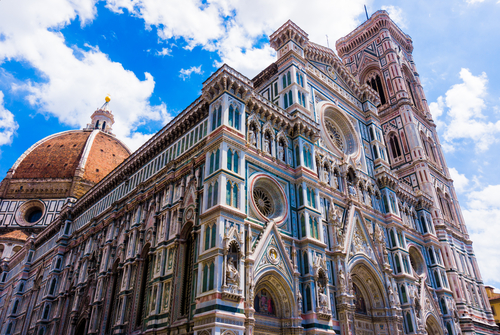When considering the development of doctrine, do not discount that winners make the final decision. Even legitimate councils that rescue the papacy can be found to be in discontinuity:
Once again, Christendom found itself split, but if the concilarist theologians had prevailed at the time of the Great Schism, in this phase the Pope was sustained by a great theologian: the Spanish Dominican, Juan de Torquemada (1388-1468) (not to be confused with the Inquisitor of the same name). Torquemada decorated by Eugene IV with the title Defensor fidei, is author of a Summa de Ecclesia, wherein he affirms with vigour the primacy of the Pope and his infallibilitas. In this work, he dissipates with great precision the ambiguities that had been created in the 14th century starting with the hypothesis of a heretic Pope. This case, according to the Spanish theologian, is concretely possible, but the solution to the problem should not be sought in any way in concilarism, which negates pontifical supremacy. The possibility of heresy in the Pope, does not compromise the dogma of infallibility, as even if he wanted to define a heresy ex cathedra, his office would be lost at that very same moment. (Pacifico Massi, Magistero infallibile del Papa nella teologia di Giovanni de Torquemada, Marietti, Torino 1957, pp. 117-122). Torquemada’s theses were developed the following century by one of his Italian confreres, Cardinal Cajetan.
The Council of Florence was very important as, on July 6th 1439, it promulgated the decree Laetentur Coeli et exultet terra, which brought the Eastern Schism to an end, but principally because it condemned concilarism definitively, by confirming the doctrine of the Pope’s supreme authority over the Church. On September 4th 1439, Eugene IV, defined solemnly: “We likewise define that the holy Apostolic See, and the Roman Pontiff, hold the primacy throughout the entire world; and that the Roman Pontiff himself is the successor of blessed Peter, the chief of the Apostles, and the true vicar of Christ, and that he is the head of the entire Church, and the father and teacher of all Christians; and that full power was given to him in blessed Peter by our Lord Jesus Christ, to feed, rule, and govern the universal Church, as is attested also in the acts of ecumenical councils and the holy canons.” (Denz-H, n. 1307).
In the letter, Etsi dubitemus, of April 21st 1441, Eugene IV condemned the heretics of Basel and the “diabolical founders” of the ‘conciliarism’ doctrine: Marsilius of Padua, Jean of Jandun and William of Ockham (Epistolae pontificiae ad Concilium Florentinum spectantes, Pontificio Istituto Orientale, Roma 1946, p. 28, 24-35), but towards Haec Sancta he held a hesitant stance, proposing what in modern terms might be defined as a “hermeneutic of continuity”. In the decree of September 4th 1439, Eugene IV states that the superiority of Councils over the Pope, asserted by the Basel Fathers on the basis of Haec Sancta, is “a bad interpretation given by the Basel Fathers themselves, which de facto is revealed as contrary to the genuine sense of the Sacred Scriptures, of the Holy Fathers, and of the Council of Constance itself.” (Decreto del 4 settembre 1439, in Conciliorum Oecumenicorum Decreta, EDB, Bologna 2002. p. 533). Eugenio IV himself, ratified the Council of Constance as a whole and in its decrees, excluded: “any prejudice to the rights, dignity and pre-eminence of the Apostolic See” as he writes to his legate on July 22nd 1446.
The hermeneutic of “continuity” thesis between Haec Sancta and the Tradition of the Church was soon abandoned. Haec Sancta is certainly the authentic act of a legitimate ecumenical Council, ratified by three Popes, but this is not enough to render binding on the doctrinal level a Magisterial document which is posed in contrast with the perennial teaching of the Church. Today we regard that only those documents, which do not damage the rights of the Papacy and do not contrast with the Tradition of the Church can be accepted from the Council of Constance. These documents do not include Haec Sancta, which is a formally heretical conciliar act.
Instead of scripture, tradition and magisterium, it should be beware the fine print.


I guess ecumenical councils are infallible except when they aren’t. Who would’ve guessed?
LikeLike
Robert, so how do you tell when a Council is true or not? Email James Young.
LikeLike
Darryl,
Ding. Actually, you just look at how the current Magisterium deals with it. The Magisterium alone is the infallible source of faith and life.
LikeLike
Robert, continuing revelation in medieval garb.
LikeLike
Darryl,
What is astounding to me is all the double-talk. Rome, even if she denies it formally, believes in some kind of ongoing divine revelation in practice. You have it on the popular level with the church looking away when apparitions of Mary reveal the future to devotees. And you have it on the official level with pronouncements about what happened to Mary. I’m not actually sure why RC apologists are so keen to deny it. People really love ongoing revelation. Witness the Mormons, the Pentecostals, certain branches of Shitte Islam, necromancy, etc.
I also love the notion put forward by James and others that the laity can correct the Magisterium. Sure. As long as the Magisterium agrees that the laity is correct. But if the laity’s reading of the deposit is different than the Magisterium’s and the Magisterium won’t abandon it’s interpretation no matter how strained, the Magisterium wins every time, at least up through V2. To be fair, it now seems that the Magisterium doesn’t much care what people believe.
LikeLike
Robert, well the laity could vote with their purses and stop playing Bingo. The problem is Europe where the states collect taxes that go to the bishops. There’s a reason the bishop in Germany earned the nickname “Bishop of Bling.”
LikeLike